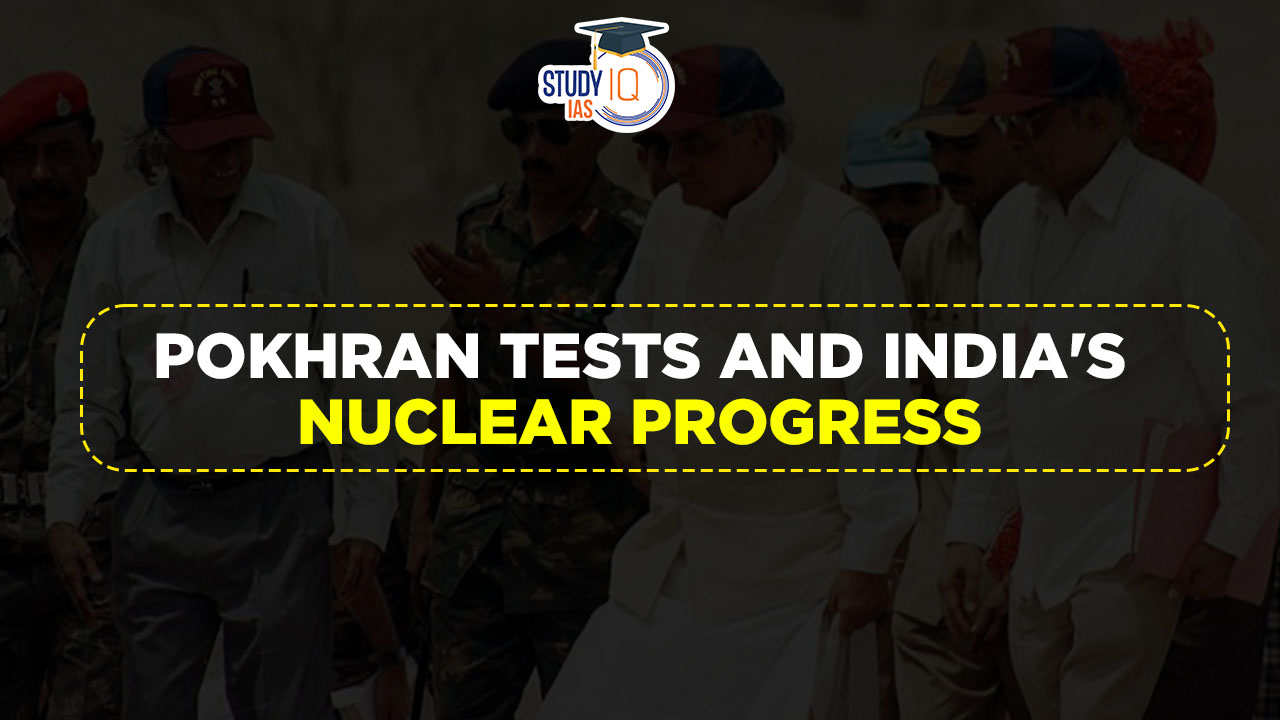Table of Contents
Context: Pokhran Nuclear test has recently marked its 25 years of completion. In the past 25 years, India has achieved several milestones in the field of defence, nuclear reactor capacity, and energy security.
About Pokhran Nuclear Tests
- The Pokhran nuclear tests refer to a series of underground nuclear weapon tests conducted by India in May 1998 at the Pokhran test range in the state of Rajasthan.
- These tests, comprising of five detonations, were codenamed “Operation Shakti” and marked India’s second round of nuclear tests, with the first one taking place in 1974.
- The tests included both fission and thermonuclear devices, showcasing India’s capability to produce nuclear weapons.
- The Pokhran tests brought India into the spotlight of global nuclear powers and had significant geopolitical implications, shaping India’s stance on nuclear disarmament and its position as a nuclear-armed nation.
- Every year since 1998, May 11 is observed as National Technology Day in India to mark Pokhran tests.
25 years of India’s Nuclear progress since the Pokhran tests
| Defence | According to the Federation of American Scientists (FAS), India currently has approximately 160 nuclear warheads.
India is also part of an elite group of global military powers having an operational nuclear triad capability. That means India can launch nuclear weapons from land, air, and sea. India has Agni, Prithvi, and K series ballistic missiles, fighter aircraft, and nuclear submarines as delivery systems for the triad. |
| Rise of nuclear power generation in India | According to the data from PIB, in the year 2003-04 the annual nuclear power generation stood at 17,700 million units, in the latest year of 2021-22 it stands at 47,112 million units, which is a nearly 165 per cent increase.
Nuclear energy currently accounts for around 3% of India’s total electricity generation. Currently, India has 22 operational nuclear reactors in the country while the government approved as many as 11 indigenous pressurized heavy water reactors in 2017 at a total cost of Rs 1.05 lakh crore and a total capacity of 7,000 Mega Watts. Today, India is the sixth largest in the world in the number of functional reactors and the second largest in the total number of reactors including those under construction. |
| Energy security for the future | The government has planned to increase the installed capacity base of nuclear power in the country for increased electricity production from nuclear power.
The present capacity of 6,780 MW would reach 13,480 MW by the year 2024-25 with the completion of projects under construction. The government has also accorded administrative approval and financial sanction for 12 nuclear power reactors aggregating a total capacity of 9,000 MW, which are scheduled to be completed progressively by the year 2031. On their completion, the total nuclear power capacity would reach 22,480 MW. |
What is Nuclear Energy?
- Nuclear energy is a type of energy that is generated by the process of nuclear reactions- either nuclear fission or nuclear fusion.
- The energy released during these reactions can be harnessed and used to produce electricity, heat, or other forms of energy.
- Nuclear fission: It is a process in which the nucleus of an atom is split into two or more smaller nuclei, releasing a large amount of energy in the process.
- This process is used in nuclear power plants to generate electricity.
- One example of nuclear fission is the reaction that occurs in a nuclear reactor when uranium atoms are split into smaller atoms.
- Nuclear fusion: It is a process in which two or more atomic nuclei come together to form a single, more massive nucleus, releasing a large amount of energy in the process.
- This process occurs naturally in stars, including our own sun.
- One example of nuclear fusion is the reaction that occurs in a hydrogen bomb.
Nuclear Enrichment
- Natural uranium consists of two different isotopes – nearly 99% U-238 and only around 0.7% of U-235.
- U-235 is a fissile material that can sustain a chain reaction in a nuclear reactor.
- Enrichment process increases the proportion of U-235 through the process of isotope separation (U-238 is separated from U-235).
- For nuclear weapons, enrichment is required up to 90% or more which is known as weapons-grade uranium.
- Low-enriched uranium, which typically has a 3-5% concentration of U-235, can be used to produce fuel for commercial nuclear power plants.
- Highly enriched uranium has a purity of 20% or more and is used in research reactors.
- Methods for uranium enrichment:
- The most common method of enrichment is through the use of centrifuges, which spin at high speeds to create a centrifugal force that separates the isotopes based on their weight.
- Another method is gaseous diffusion, where uranium hexafluoride gas is forced through a series of barriers, allowing the lighter U-235 to diffuse more rapidly and become more concentrated.

Significance of Nuclear Energy
- Low carbon emissions: Nuclear energy is a low-carbon source of power that does not release greenhouse gases into the atmosphere, unlike fossil fuels.
- Reliability: Nuclear power plants can run for long periods of time without interruption and are highly reliable sources of electricity.
- High energy density: Nuclear fuel contains a high energy density, meaning that it can produce a large amount of energy from a small amount of fuel.
- Independence from fossil fuels: Nuclear power does not depend on fossil fuels, which are finite resources subject to price fluctuations and environmental pollution.
- Base load power: Nuclear power can provide reliable base load power to complement intermittent renewable energy sources like wind and solar power.
- Energy security: Nuclear power can help to increase energy security by reducing reliance on foreign sources of oil and gas.
- Advanced technologies: Nuclear power research and development has led to advances in technologies like medical imaging, food irradiation, and space exploration.

India’s Nuclear Energy Potential
- India has significant reserves of thorium, a naturally occurring radioactive element that can be used as a fuel in nuclear reactors.
- With the world’s largest reserves of thorium, estimated at around 360,000 tonnes, India has the potential to become a major player in the nuclear energy sector.
- In addition to thorium, India also has significant reserves of uranium (70,000 tonnes), which can be used as a fuel in nuclear reactors.
India’s Three-Stage Nuclear Power Programme
- India’s three-stage nuclear power programme was formulated by Homi Bhabha in the 1950s to secure the country’s long term energy independence, through the use of uranium and thorium reserves found in the monazite sands of coastal regions of South India.
- The ultimate focus of the programme is on enabling the thorium reserves of India to be utilized in meeting the country’s energy requirements.
| Stage I – Pressurized Heavy Water Reactor [PHWR] | The first stage of India’s nuclear program involves the use of PHWRs fuelled by natural uranium.
These reactors generate electricity while also producing plutonium-239 as a by-product. |
| Stage II – Fast Breeder Reactor (FBR) | The second stage of India’s nuclear program involves the use of FBRs fuelled by a mix of plutonium-239 and uranium-238.
These reactors generate more plutonium-239 than they consume and can also convert thorium into uranium-233, which can be used as fuel in the third stage. |
| Stage III – Thorium Based Breeder Reactors | The third and final stage of India’s nuclear program involves the use of thorium-based reactors fuelled by uranium-233 produced in FBRs.
These reactors are designed to use thorium as a fuel, which is abundant in India, and have the potential to provide a sustainable source of nuclear energy for the country. |
What are the concerns associated with Nuclear Energy?
- Nuclear accidents: Nuclear accidents can have catastrophic consequences, as seen in Chernobyl and Fukushima.
- Radioactive waste: Nuclear power plants produce radioactive waste that remains dangerous for thousands of years and must be carefully stored to prevent contamination.
- The Fukushima disaster in 2011 resulted in a significant release of radioactive materials into the environment. These materials (nuclear waste), can remain radioactive and dangerous for thousands of years.
- Limited Domestic Resources: India has limited domestic resources of uranium, which is the fuel for nuclear reactors.
- This has forced the country to import a significant portion of its uranium requirements, making the country’s nuclear energy program vulnerable to global market conditions and political tensions.
- Proliferation risk: The technology and materials used in nuclear power plants can be used to make nuclear weapons, making nuclear power a proliferation risk.
- High cost: Nuclear power plants are expensive to build and maintain, and the high costs can make it difficult for countries to justify building new plants.
- Security risks: Nuclear power plants and nuclear waste storage facilities can be targets for terrorism or other security threats.
- Decommissioning challenges: Decommissioning nuclear power plants at the end of their useful life is a complex and costly process that can take decades to complete.
- International Sanctions: India is not a member of the Nuclear Non-Proliferation Treaty (NPT) and has faced international sanctions in the past for its nuclear weapons program.
- This has limited its access to advanced nuclear technology and fuel supplies from other countries.
- Public opposition: Nuclear energy is a polarizing issue that can generate significant public opposition due to concerns about safety and waste storage.

Recent Developments in the India’s Nuclear Landscape
- Joint Ventures with Public Sector Undertakings (PSUs): Government has also allowed Joint Ventures with PSUs to enhance India’s nuclear program.
- As a result, the Nuclear Power Corporation of India Limited (NPCIL) is now in two joint ventures with the National Thermal Power Corporation Limited (NTPC) and the Indian Oil Corporation Limited (IOCL).
- Diversifying the geographical spread: In the past, India’s nuclear installations were mostly located in South India or in Maharashtra and Gujarat in the west. However, the government is now promoting its expansion to other parts of the country.
- As an example, the upcoming nuclear power plant in Gorakhpur town of Haryana, which will become operational in the near future.
- Indigenization: The world’s first thorium-based nuclear plant, “Bhavni,” using Uranium-233, is being set up at Kalpakkam in Tamil Nadu. This plant will be entirely indigenous and will be the first of its kind. The experimental thorium plant “Kamini” already exists in Kalpakkam.


 Daily Quiz 17 April 2025
Daily Quiz 17 April 2025
 Nilgiri Biosphere Reserve, Map, Climate,...
Nilgiri Biosphere Reserve, Map, Climate,...
 Complete List of Indian State Animals
Complete List of Indian State Animals





















